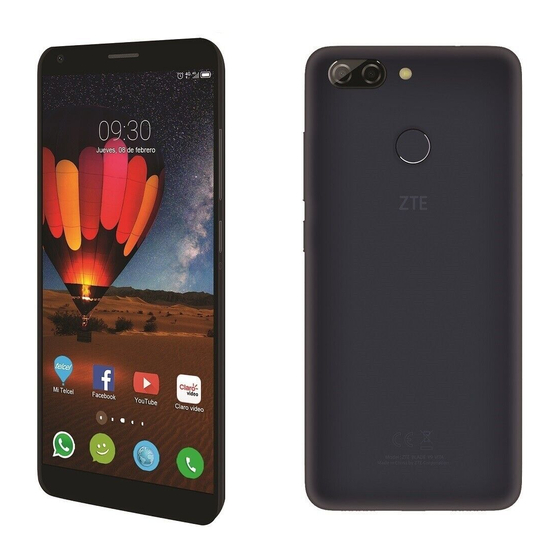
Table of Contents
Advertisement
Quick Links
Advertisement
Table of Contents

Summary of Contents for Zte BLADE V9
- Page 1 ZTE BLADE V9 User Manual...
- Page 2 Content in this guide may differ from the actual product or software. Trademarks ZTE and the ZTE logos are trademarks of ZTE Corporation. Android is a trademark of Google LLC; Oreo is a trademark of Mondelez International, Inc. group.
- Page 3 Headphone:X, DTS:X, the DTS Headphone:X logo, and the DTS:X logo are registered trademarks or trademarks of DTS, Inc. in the United States and/or other countries. © DTS, Inc. All Rights Reserved. Other trademarks and trade names are those of their respective owners.
-
Page 4: Getting To Know Your Phone
Getting to Know Your Phone Proximity Earpiece & light sensor Front camera Indicator light Touch screen Auxiliary microphone Headset jack Dual-lens Flash camera nano-SIM/ microSDXC card tray Volume key Fingerprint sensor Power key Charging /micro-USB jack Main microphone Speaker... -
Page 5: Installing The Nano-Sim Card And The Microsdxc™ Card (Optional)
Installing the nano-SIM Card and the microSDXC™ Card (Optional) The nano-SIM card can be installed or removed while the phone is turned on. WARNING! To avoid damage to the phone, do not use any other kind of SIM cards, or any non-standard nano-SIM card cut from a SIM card. -
Page 6: Charging The Phone
You should fully charge the battery as soon as possible. WARNING! Use only ZTE-approved chargers and USB cables. The use of unapproved accessories could damage your phone or cause the battery to explode. -
Page 7: Product Safety Information
Product Safety Information Don’t make or receive phone calls while driving. Never text while driving. Keep your phone at least 10 mm away from your body while making calls. Small parts may cause choking. Your phone can produce a loud sound. To prevent possible hearing damage, do not listen at high volume levels for long periods. -
Page 8: Fcc Rf Exposure Information (Sar)
Don’t rely on your phone as a primary device for emergency communications. FCC RF Exposure Information (SAR) This phone is designed and manufactured not to exceed the emission limits for exposure to radio frequency (RF) energy set by the Federal Communications Commission of the United States. -
Page 9: Fcc Regulations
against the head is 0.375 W/kg, and for usage near the body is 1.433 W/kg. While there may be differences between the SAR levels of various phones and at various positions, they all meet the government requirements. SAR compliance for body-worn operation is based on a separation distance of 10 mm between the unit and the human body. - Page 10 These limits are designed to provide reasonable protection against harmful interference in a residential installation. This equipment generates, uses and can radiate radio frequency energy and, if not installed and used in accordance with the instructions, may cause harmful interference to radio communications.











Need help?
Do you have a question about the BLADE V9 and is the answer not in the manual?
Questions and answers